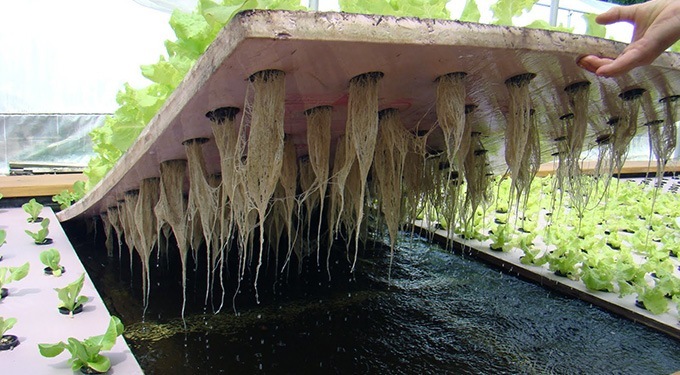Deep Water Cultivation Systems - Page 2

A view of the mature root masses dangling from lettuce plants, still in their raft. Additional rafts can be seen on either side. Choosing the right raft material is a critical part of a successful DWC system. The rafts need to be buoyant enough to float, light enough to lift, stiff enough to resist bending or folding while being moved, and inexpensive enough to be easily purchased and replaced. Styrofoam is uniquely suited for raft material because it perform all of these tasks quite well. Image courtesy of www.epicgardening.com.
You are on Page 2 of our six page series on deep water cultivation systems. Click on any of the below pages to jump to that page.
Page 1 Page 2 Page 3 Page 4 Page 5 Page 6
Given all the advantages listed on Page 1, you might think that deep water cultivation is the be-all-and-end-all answer to every hydroponic project. Not quite. The system does have some disadvantages. For one thing, DWC is more limited than most in the plants it can grow well. Because the roots are constantly dangling in water, moisture-loving plants like salad greens will grow well, but those plants which prefer moderate to dry conditions will not. This latter group includes a lot of herbs and some other common vegetables.
Secondly, the rafts are sensitive to the weight of the plants they carry, and if the plants get too large or heavy, the raft can become destabilized or begin sinking. While many plants enjoy having their roots in water, few plants want their aerial stems submerged for any length of time.
Third, rafts by definition need to float on the reservoir surface. That implies a reservoir which has sufficient surface area to carry the desired number of rafts. This can get into a situatin where the reservoir size and dimensions are determined not only by the capacity needed to feed the plants, but also to carry the rafts. As such, growers need to carefully calculate the raft size, planting density on each raft, typical root length for the chosen crop(s) and number of rafts needed per growing season. This becomes even more important if multiple crops will be cycled through the system each year. All those variables will go into determining the reservoir size. And thanks to these variables, the reservoir itself may end up being large enough that construction costs will be considerable. Smaller systems and hobbyist systems won’t be impacted by this as much. However, commercial-scale operations will need to carefully calculate their reservoir size. This element of the system cannot easily or inexpensively be re-done if those initial calculations are incorrect, or if the situation changes.
And finally, let’s talk briefly about scalability. This is a rough measure of how easily a system can be increased or decreased in size. Deep water culture, being dependent upon a reservoir of certain size, is less adaptable than most other hydroponic systems to changes in size. This is because the reservoir is already carefully matched to production size, with most or all of the available surface area already in use. Since the reservoir size can’t easily be changed, growers will have to carefully consider the options for either expanding or reducing their operations. We’ll talk more about this issue in the Scaleability section.
One element of deep water cultivation is important to note, but I won’t lump it in with either advantages or disadvantages, because it could go either way. The nutrient solution reservoir may become so large that it becomes a thermal sink. This, in turn, will dramatically impact the growth rate and even the fruiting habits of the relevant crop(s). This can be advantageous in some situations. Any given crop has preferred temperatures not only for the aerial portions of the plant, but for the root zone as well. For instance, cool-season plants such as salad greens and strawberries prefer relatively cool conditions for both their aerial and root zones. If the crops are being grown in hot climates, production can be improved throughout the year by keeping the nutrient solution cool. Similarly, warm-season crops prefer warm roots, and will benefit from a nutrition solution that is kept warm. Insulated reservoirs can help ensure that whatever temperature is needed, can be maintained cost effectively.
All that being said, sometimes environmental conditions provide a real challenge to maintaining nutrient solution temperatures. Two drastic examples can illustrate this issue. Suppose that a grower in the hot, dry American southwest desert area wants to grow salad greens year-round. Everything about that environment will try to heat up the nutrient solution to temperatures which are much too warm for salad greens. Conversely, suppose that a grower in an Arctic location such as Alaska wants to grow warm-season plants year-round. That particular environment features extremely cold conditions for much of the year, cold enough to slow down, damage or even kill warm-season plants.
These extreme examples don’t mean that deep water culture is impossible in these challenging environments. Instead it’s meant as a cautionary note, that environmental conditions must be taken into consideration. Granted, most environments won’t be so challenging, and the thermal sink nature of DWC can be used very advantageously to boost production, or it will be a neutral issue. Just remember that there will be a point at which the costs involved in using this particular method, may simply be too high for the given crop + environment. To be fair, this issue just as frequently goes in the other direction, where the thermal sink nature of DWC can benefit the intended crops. If anything, this is a wonderful example of planning out any operation carefully in advance, so that challenging conditions can be addressed up front.
Back Next
You are on Page 2 of our six page series on deep water cultivation systems. Click on any of the below pages to jump to that page.
Page 1 Page 2 Page 3 Page 4 Page 5 Page 6